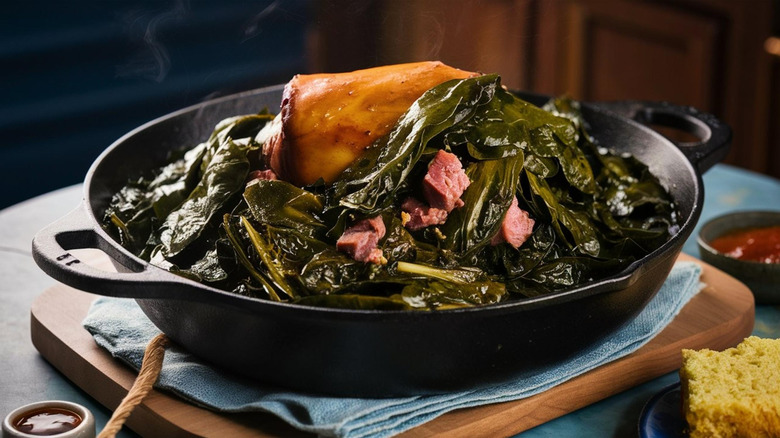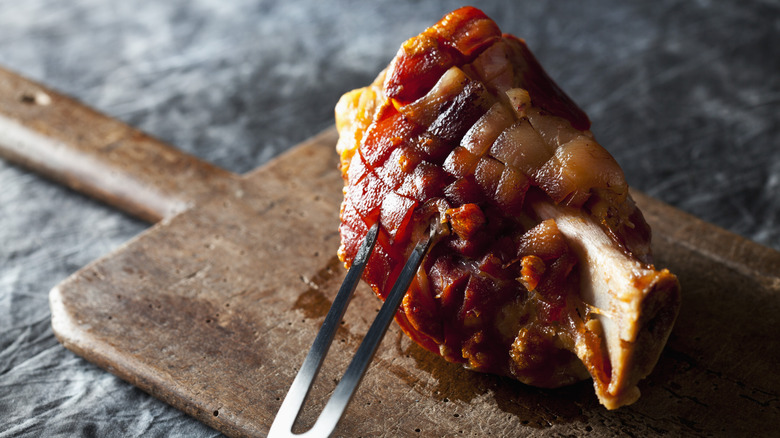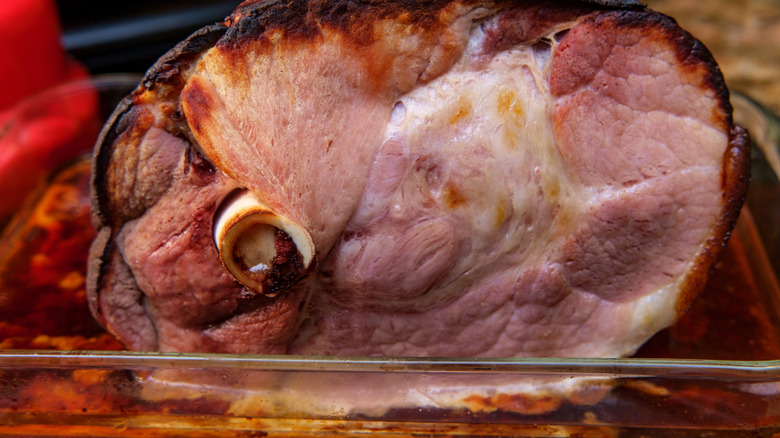Are Ham Hocks And Ham Bones Exactly The Same?
Ham hocks and ham bones are often mentioned like they're one and the same, but are they actually interchangeable in recipes? Both are seen as huge flavor boosters for various types of dishes — like soups, stews, and broths — but they serve slightly different purposes.
Ham hocks come from the pig's lower leg — specifically, the joint that connects the leg and the foot. There's a little meat, a good amount of fat, and tons of connective tissue in that region, and it breaks down when you cook it slowly. You end up giving a luxurious and rich texture to whatever you added it to. However, there's not really enough meat for you to use it as the main source of protein in a meal. However, you will end up with succulent bits of rich, smoky meat, which makes ham hocks great in side dishes and soups.
Ham bones come from the ham cut, which is located on the upper back leg of a pig. With the ham bone, there's some leftover meat. However, the amount will depend on how you cut that spiral ham roast or the specific bones you bought from the market. Even if there isn't a ton of protein left, they are still savory and smoky — a great addition to soups and collard greens.
Understanding the unique qualities of each can help you decide which to use based on your recipe. Whether you're simmering a pot of beans or creating a homemade stock, knowing the difference between ham hocks and ham bones will improve your cooking.
Ham hocks are the perfect addition to comfort food classics
Ham hocks offer flavor, texture, and versatility. When cooked low and slow, the hock releases collagen and fat, creating a silky smooth, überflavorful, hearty broth that serves as the foundation for delicious dishes like beans, lentils, and soups.
Ham hocks are typically cured and smoked (though sometimes they're unsmoked), infusing recipes with a deeply unctuous flavor. Ham hocks also contribute more fat than just the ham bones, which enhances the richness of a dish. They're particularly popular in Southern cooking, where they're used to season everything from collard greens to black-eyed peas. I think they're amazing with pretty much any canned beans you have in the pantry because the legumes soak up so much of that smoky, meaty flavor.
Even after the hock has flavored your dish, the tender meat can be shredded and added back in for extra heartiness. Ham hocks are an addition that can easily turn simple ingredients into comfort food classics. Try making a pot of chili or a bowl of rustic soup; adding a ham hock ensures a complex, smoky depth of flavor that's hard to replicate.
Ham bones are delicious and versatile
Leftover bones from a holiday ham or a raw ham roast are a frugal cook's dream, offering a second life to what might otherwise be discarded. When simmered, the marrow and any remaining meat release a deep umami flavor, perfect for enriching broths, soups, and even rice dishes.
One of the best uses for ham bones is making a homemade stock. The process is simple: Combine the bone with water, onions, carrots, celery, and aromatics, and then simmer for hours until you have a richly flavored liquid base. This stock can then be used to elevate dishes like risotto, gravy, or gumbo. The bone's collagen content also adds a subtle thickness to the liquid, making it ideal for hearty winter recipes.
Though less fatty than hocks, ham bones can still hold their own in the flavor department. They're particularly good in recipes where you want a smoky essence without too much additional fat. Whether you're looking for simple ways to use up leftover ham or starting fresh, ham bones are an economical and delicious way to infuse your meals with depth and complexity.


